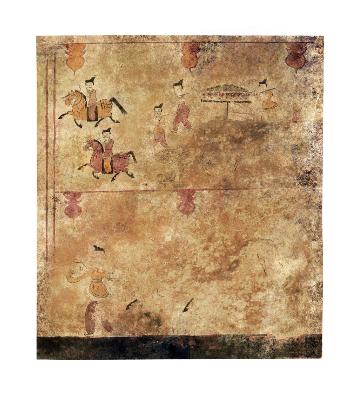- Koguryo and Balhae
- Tokhung-ri Tomb
Koguryo and Balhae
| Title | Western Wall of the Middle Passage | ||
|---|---|---|---|
This mural on the western wall of the middle passage portrays Provincial Governor Jin in the Depiction of the Noble Couple’s Outing. It is a counterpart to the mural on the eastern wall featuring his wife. A red, rectangular border frames the image that was divided into two smaller frames. The top portion portrays Jin riding in a horse carriage being escorted by soldiers, and the bottom features mostly decorations and partial images. When compared with the lower portion of the mural painted on the eastern wall, however, the indiscernible images can be surmised to be a military attaché leading a horse.
Jin is riding in a horse carriage while being escorted by soldiers in an outing. Two mounted soldiers can be seen leading the procession, and infantrymen carrying Hwandudaedos (ring-pommel sword mostly found in Three Kingdoms Period tombs) on their shoulders surround the carriage. All escorts can be seen wearing military attaché Chaeks (Headwear worn by civil servants and military attachés. Civil servants wore Chaeks with tops that were split in the back and curving forward. Military attachés wore Chaeks with cone-shaped points.) indicating that they are of higher rank than the escorts in the mural on the eastern wall. The horse pulling the carriage and two men walking in front of the carriage are nearly impossible to discern due to deterioration. The canopy on the carriage features two levels of tassel decorations, and its appearance is particularly elegant.
Due to the severe degradation of the bottom portion, only the horse's legs and a figure wearing a military attaché Chaek are vaguely visible. They are estimated to be a part of the procession.
The Depiction of the Noble Couple’s Outing was a very popular motif from early Koguryo era tomb murals and generally interpreted to be a representation of actual outings undertaken by the nobles during their lifetime. Alternately, these depictions also symbolize a journey to the afterlife escorted by valets and maids. In this instance, the horse and ox carriages are important modes of transport for comfortably and safely reaching the afterlife. The portrait of the deceased painted on the northern wall of the main chamber is flanked by an ox carriage and a horse, symbolizing preparations for the deceased couple's impending outing. The traveling processions face out of the main chamber (house) toward the antechamber (outbuilding), indicating that they have just embarked on an outing rather than returning.














